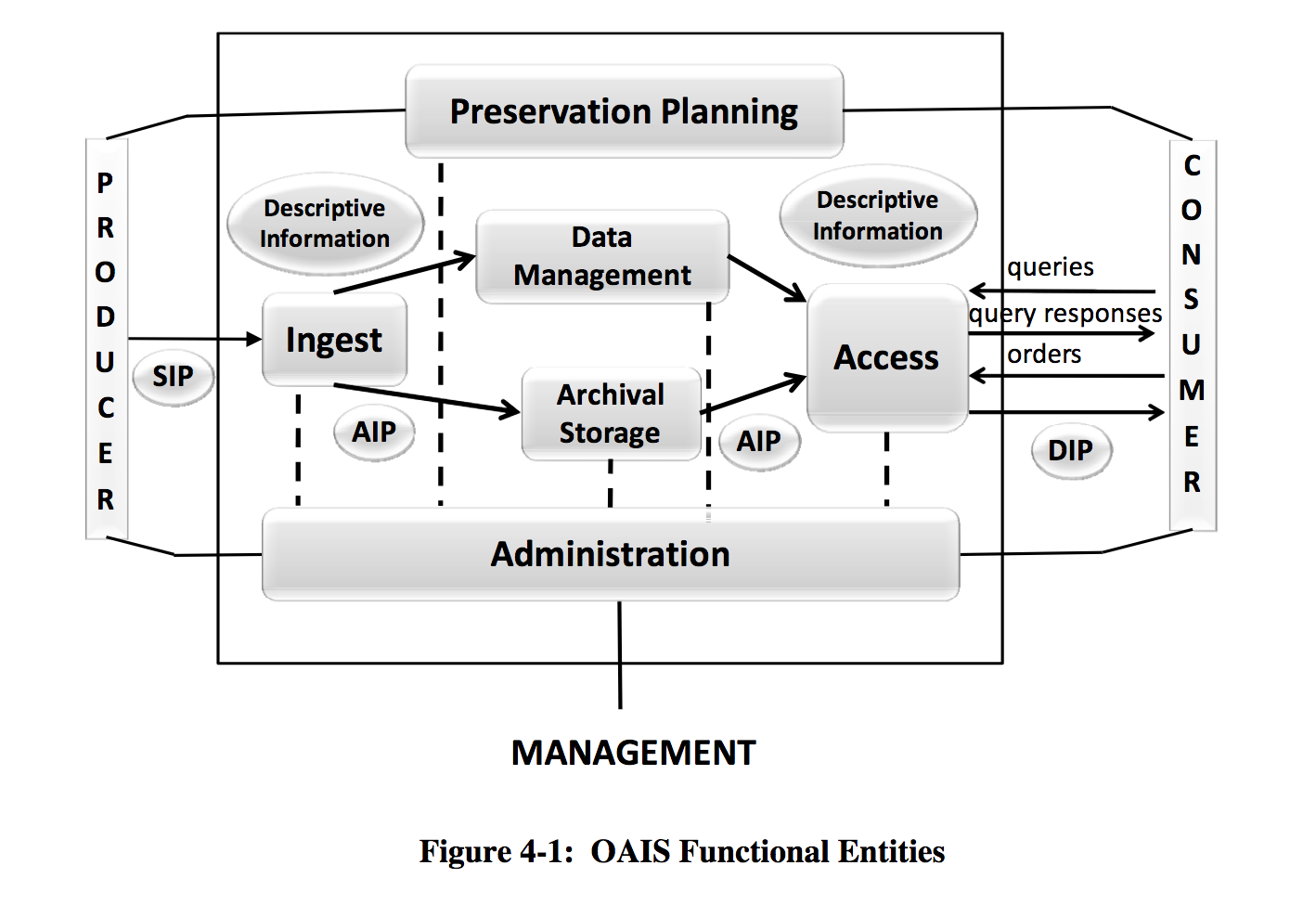This page intentionally left blank. ⬇️, ➡️, or spacebar 🛰 to start slidedeck. --- class: middle, center # OAIS --- # Open Archival Information System 🚀 Created for space data, and for some reason preservationists just love it. # 🚀 # .center[ 🚀 ] # .right[ 🚀 ] --- # Vocab: OAIS *Officially: An Archive, consisting of an organization, which may be part of a larger organization, of people and systems, that has accepted the responsibility to preserve information and make it available for a Designated Community. It meets a set of responsibilities, as defined in section 4, that allows an OAIS Archive to be distinguished from other uses of the term ‘Archive’. The term ‘Open’ in OAIS is used to imply that this Recommendation and future related Recommendations and standards are developed in open forums, and it does not imply that access to the Archive is unrestricted.* Simply: An Open Archival Information System is a repository that complies with drafted standards, and the OAIS Reference Model is the guide which has established these standards. --- # Vocab: Information packages Information bundled and includes - Context: describes the relationship of the information to its environment. - Identifiers: a method or methods with which to reference the material. - Fixity: a wrapper over the information to verify lack of undocumented alternation and data integrity - Access rights: provides terms of access, preservation, distribution, and usage --- # Vocab: SIP, AIP, DIP **Submission Information Package (SIP)** *Officially: An Information Package that is delivered by the Producer to the OAIS for use in the construction or update of one or more AIPs and/or the associated Descriptive Information.* Simply: the information sent from the producer to the archive **Archival Information Package (AIP)** *Officially: An Information Package, consisting of the Content Information and the associated Preservation Description Information (PDI), which is preserved within an OAIS.* Simply: the information stored by the archive **Dissemination Information Package (DIP)** *Officially: An Information Package, derived from one or more AIPs, and sent by Archives to the Consumer in response to a request to the OAIS.* Simply: the information sent to a user when requested --- # First... THE DIAGRAM .center[] --- # Functional Entities There are six functional entities in an OAIS: - Ingest - Archival storage - Data management - Administration - Preservation planning - Access --- # "Pre-Ingest" Before we get into the six functional entities, something comes up very frequently in conversations and that is what gets referred to as the "pre-ingest" stage. In this stage, a preservationist may perform a variety of tasks to prepare the material received from the archive and make it ready for the OAIS. --- # Ingest **The Ingest function...** - receives information from producers and packages it for storage - accepts a SIP and verifies it - creates an AIP from the SIP - transfers the newly created AIP to archival storage --- # Archival storage **The Archival storage function...** - stores, maintains, and retrieves AIPs - accepts AIPs submitted by the Ingest function - assigns AIPs to long term storage - migrates AIPs (when necessary) - checks AIPs for errors - sends AIPs to the Access function (when requested) --- # Data management **The Data management function...** - coordinates descriptive information of AIPs with the system information - maintains the archive's database - executes query requests and delivers their results - generates reports - updates the database --- # Administration **The Administration function...** - manages the daily operations of the archive - attains submission agreements from information producers - performs system engineering - audits SIPs to ensure compliance with submission agreements - develops policies and standards. - acts as interface --- # Preservation planning **The Preservation planning function...** - keeps the archive material accessible and understandable even if the original computing system becomes obsolete - development of detailed preservation/migration plans - evaluation and risk analysis of content - recommendation of update and migration --- # Access - the user interface that allows users to retrieve information from the archive - generates a DIP from the relevant AIP - delivers DIPs as requested --- # Conclusion This is just a very brief and high-level overview of the OAIS structures. There is much more information and context that may be found in the original reference model, linked on the next page. --- # Additional Resources - [Reference Model for an Open Archival Information System](http://public.ccsds.org/publications/archive/650x0m2.pdf) [PDF] - [Archivematica Introduction Documentation](https://www.archivematica.org/en/docs/archivematica-1.6/getting-started/overview/intro/#intro) - [DPC OAIS Community](http://wiki.dpconline.org/index.php?title=OAIS_Community) - [Meeting the challenges of digital preservation: The OAIS reference model](http://www.oclc.org/research/publications/library/2000/lavoie-oais.html) - [METS for Transferable Metadata](https://easydigitalpreservation.wordpress.com/2010/06/30/mets-for-transferable-metadata/) - [OAIS Reference Model Part I: Background and Influence](https://easydigitalpreservation.wordpress.com/2009/07/29/oais-reference-model-part-i-background-and-influence/) - [Visualizing OAIS](http://wiki.dpconline.org/index.php?title=Visualizing_OAIS) - [What repositories do: the OAIS Model](https://everybodyslibraries.com/2008/10/13/what-repositories-do-the-oais-model/) - [Wikipedia](https://en.wikipedia.org/wiki/Open_Archival_Information_System) --- # Learning more [Home](/)